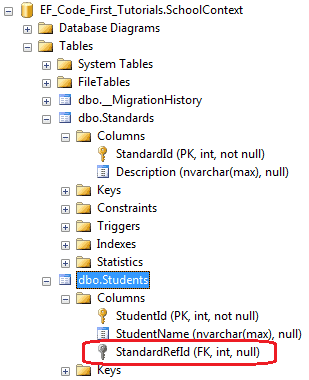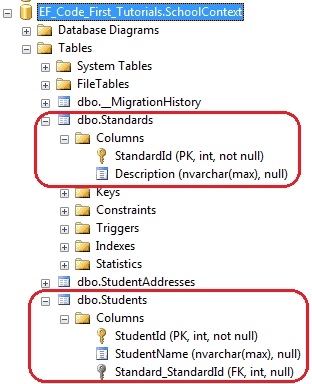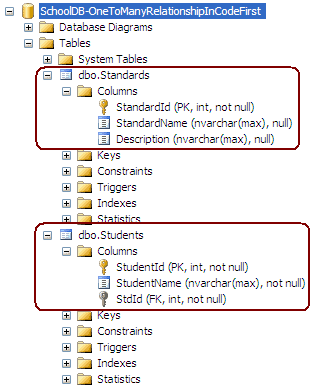Entity Framework Code-First(12):Configure One-to-Many
Configure One-to-Many Relationship:
Here, we will learn how to configure One-to-Many relationship between two entities in code-first. Take an example of Student and Standard (grade) entities where one Standard can include many Students. So the relation between Student and Standard entities would be one-to-many.
Visit Entity Relationship section to understand how EF manages one-to-one, one-to-many, and many-to-many relationships between the entities.
Configure One-to-Many relationship using DataAnnotations:
Consider the following Student and Standard entity.
public class Student
{
public Student() { } public int StudentId { get; set; }
public string StudentName { get; set; } public virtual Standard Standard { get; set; }
} public class Standard
{
public Standard()
{
Students = new List<Student>();
}
public int StandardId { get; set; }
public string Description { get; set; } public virtual ICollection<Student> Students { get; set; }
}
In the above example, Student entity includes navigation property Standard and Standard entity includes collection property for Student. This is the default convention to form one-to-many relationship.
We do not need to configure for one-to-many relationships either using DataAnnotations or Fluent API, if entity classes follow this convention.
EF code-first would create one-to-many relationship by adding Standard_StandardId column in the student table as shown below.
Entity includes ForeignKey Id property:
It is recommended to include foreign key property in an entity class. For example, if Student entity includes StandardId property which automatically becomes foreignkey property because it follows the convention for foreignkey <Type Name>Id.
If foreignkey property name is not as per the convention, for example, Student entity uses different name of foreignkey for Standard entity than StandardId then we need to apply ForeignKey attribute on a property.
For example, the following Student entity includes StandardRefId property.
public class Student
{
public Student() { } public int StudentId { get; set; }
public string StudentName { get; set; } public int StdandardRefId { get; set; } [ForeignKey("StandardRefId")]
public virtual Standard Standard { get; set; }
} public class Standard
{
public Standard()
{
StudentsList = new List<Student>();
}
public int StandardId { get; set; }
public string Description { get; set; } public virtual ICollection<Student> Students { get; set; }
}
In the above example, ForeignKey attribute is applied on Standard navigation property to specify foreignkey property name for Standard property. So now, EF will create StandardRefId column as a FK as shown below.

Configure One-to-Many relationship using Fluent API:
Here, we will learn configure One-to-Many relationship between Student and Standard entities using Fluent API.
Let’s configure one-to-many for following Student and Standard entities.
public class Student
{
public Student(){ } public int StudentId { get; set; }
public string StudentName { get; set; } public int StandardId { get; set; } public virtual Standard Standard { get; set; }
} public class Standard
{
public Standard()
{
StudentsList = new List<Student>();
}
public int StandardId { get; set; }
public string Description { get; set; } public virtual ICollection<Student> Students { get; set; }
}
Now, you can configure one-to-many as shown below.
protected override void OnModelCreating(DbModelBuilder modelBuilder)
{
//one-to-many
modelBuilder.Entity<Student>()
.HasRequired<Standard>(s => s.Standard) // Student entity requires Standard
.WithMany(s => s.Students); // Standard entity includes many Students entities }
Suppose Student and Standard entity class doesn't follow Code-First conventions for foreign key. Student class will include a different foreign key name for Standard than StandardId.
public class Student
{
public Student(){ } public int StudentId { get; set; }
public string StudentName { get; set; } //StdId is not following code first conventions name
public int StdId { get; set; } public virtual Standard Standard { get; set; }
} public class Standard
{
public Standard()
{
StudentsList = new List<Student>();
}
public int StandardId { get; set; }
public string Description { get; set; } public virtual ICollection<Student> Students { get; set; }
}
So now, you can use Fluent API to configure a One-to-Many relationship using Student entity classes, as shown below.
protected override void OnModelCreating(DbModelBuilder modelBuilder)
{
//one-to-many
modelBuilder.Entity<Student>()
.HasRequired<Standard>(s => s.Standard)
.WithMany(s => s.Students)
.HasForeignKey(s => s.StdId); }
As you can see, modelBuilder.Entity<Student>().HasRequired<Standard>(s => s.Standard) specifies that Student entity requires NotNull Standard navigation property. .WithMany(s => s.Students).HasForeignKey(s => s.StdId) specifies that the other side of Student (means Standard entity ) can include many Students in Students collection property and foreign key is StdId.
Another possible way: We can also start with Standard entity.
protected override void OnModelCreating(DbModelBuilder modelBuilder)
{
//configure one-to-many
modelBuilder.Entity<Standard>()
.HasMany<Student>(s => s.Students) Standard has many Students
.WithRequired(s => s.Standard) Student require one Standard
.HasForeignKey(s => s.StdId);Student includes specified foreignkey property name for Standard
}
The code shown above will create the following database:
Notice that StdId is Not Null column. So you must assign Standard with Student entity every time you add or update Student.
Nullable foreign key for one-to-many relationship.
Use HasOptional method instead of HasRequired method to make foreign key column nullable.
protected override void OnModelCreating(DbModelBuilder modelBuilder)
{
//one-to-many
modelBuilder.Entity<Student>()
.HasOptional<Standard>(s => s.Standard)
.WithMany(s => s.Students)
.HasForeignKey(s => s.StdId); }
Learn how to configure many-to-many relationship in the next section.
Entity Framework Code-First(12):Configure One-to-Many的更多相关文章
- Entity Framework Tutorial Basics(12):Model First
Model First development with Entity Framework: In the Model First approach, you create Entities, rel ...
- Entity Framework Code first(转载)
一.Entity Framework Code first(代码优先)使用过程 1.1Entity Framework 代码优先简介 不得不提Entity Framework Code First这个 ...
- Entity Framework Code First (三)Data Annotations
Entity Framework Code First 利用一种被称为约定(Conventions)优于配置(Configuration)的编程模式允许你使用自己的 domain classes 来表 ...
- Entity Framework Code First (二)Custom Conventions
---------------------------------------------------------------------------------------------------- ...
- Entity Framework Code First (一)Conventions
Entity Framework 简言之就是一个ORM(Object-Relational Mapper)框架. Code First 使得你能够通过C#的类来描述一个模型,模型如何被发现/检测就是通 ...
- Entity Framework Tutorial Basics(11):Code First
Code First development with Entity Framework: Entity Framework supports three different development ...
- Entity Framework Code First (七)空间数据类型 Spatial Data Types
声明:本文针对 EF5+, Visual Studio 2012+ 空间数据类型(Spatial Data Types)是在 EF5 中引入的,空间数据类型表现有两种: Geography (地理学上 ...
- Entity Framework Code First (四)Fluent API - 配置属性/类型
上篇博文说过当我们定义的类不能遵循约定(Conventions)的时候,Code First 提供了两种方式来配置你的类:DataAnnotations 和 Fluent API, 本文将关注 Flu ...
- Entity Framework Code First (八)迁移 Migrations
创建初始模型和数据库 在开始使用迁移(Migrations)之前,我们需要一个 Project 和一个 Code First Model, 对于本文将使用典型的 Blog 和 Post 模型 创建一个 ...
- Entity Framework Code First (六)存储过程
声明:本文只针对 EF6+ 默认情况下,Code First 对实体进行插入.更新.删除操作是直接在表上进行的,从 EF6 开始你可以选择使用存储过程(Stored Procedures) 简单实体映 ...
随机推荐
- [算法]找到无序数组中最小的K个数
题目: 给定一个无序的整型数组arr,找到其中最小的k个数. 方法一: 将数组排序,排序后的数组的前k个数就是最小的k个数. 时间复杂度:O(nlogn) 方法二: 时间复杂度:O(nlogk) 维护 ...
- Oil Deposits -----HDU1241暑假集训-搜索进阶
L - Oil Deposits Crawling in process... Crawling failed Time Limit:1000MS Memory Limit:32768KB ...
- Luogu-4049 [JSOI2007]合金
题目中给出了三种金属的比例,实际上只用考虑两个就可以,第三个可以由另外两个确定qwq 如果把原料和需求看做二维平面上的点,可以发现两种原料能混合成的比例就在他们相连的线段上,也就是说线段上的点都能混合 ...
- TP里的关联查询
$res = $db->join('b on a.ex_id = b.pe_eid')->select(); 注意:这里的表a.表b需要带表前缀
- 51nod 1513 && CF570D
题意:给定一棵树,每个节点有一个字母.给定若干个询问,询问某个子树内某一深度的节点是否能将这些节点组合成一个回文串.(深度是以根节点为基准的,不是当前子树根.)数据规模10^5. 神犇题解 子树问题, ...
- spring mongodb 复制集配置(实现读写分离)
注:mongodb当前版本是3.4.3 spring连接mongodb复制集的字符串格式: mongodb://[username:password@]host1[:port1][,host2[: ...
- Convolutional Neural Networks for Visual Recognition 7
Two Simple Examples softmax classifier 后,我们介绍两个简单的例子,一个是线性分类器,一个是神经网络.由于网上的讲义给出的都是代码,我们这里用公式来进行推导.首先 ...
- 【leetcode刷题笔记】Path Sum
Given a binary tree and a sum, determine if the tree has a root-to-leaf path such that adding up all ...
- 微信非全屏播放设置(仅Iphone)
由于微信X5内核强制视频全屏,用X5自带内核播放,一般内嵌视频打开播放就会被全屏. ihpone里面可以通过设置 x-webkit-airplay="true" webkit-pl ...
- 2017-2018-1 20179215《Linux内核原理与分析》第五周作业
一.视频学习 1.系统调用的三层皮:xyz(API).system call(中断向量).sys_xyz(不同种类的服务程序). 2.Libc库定义个一些API引用了封装例程(wrapper rout ...


